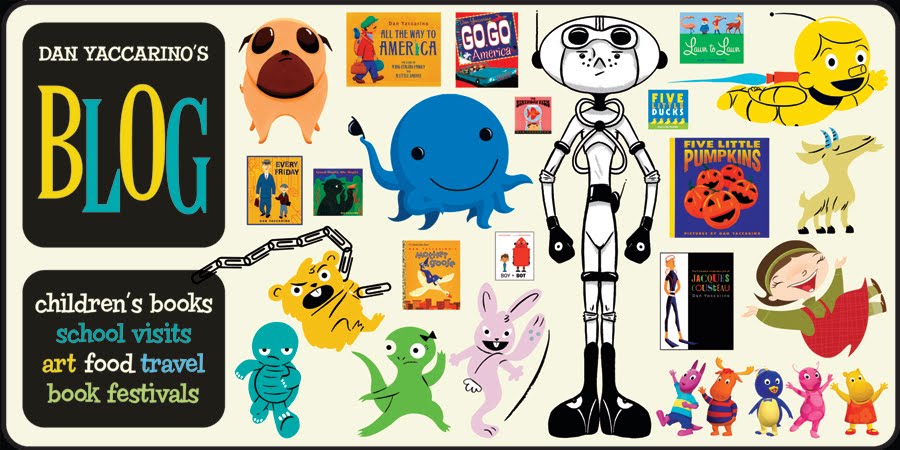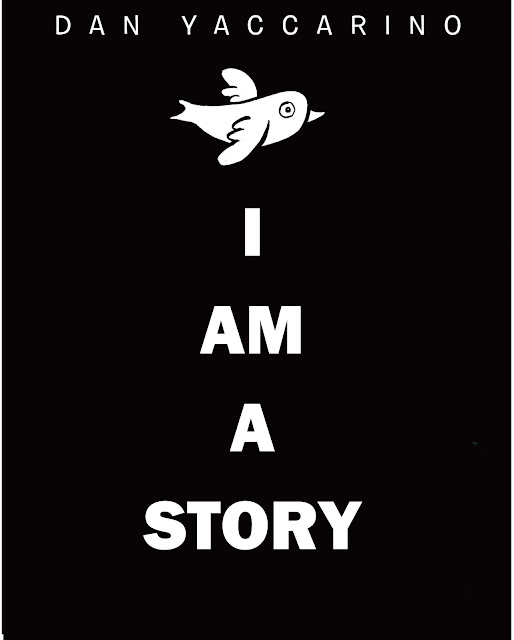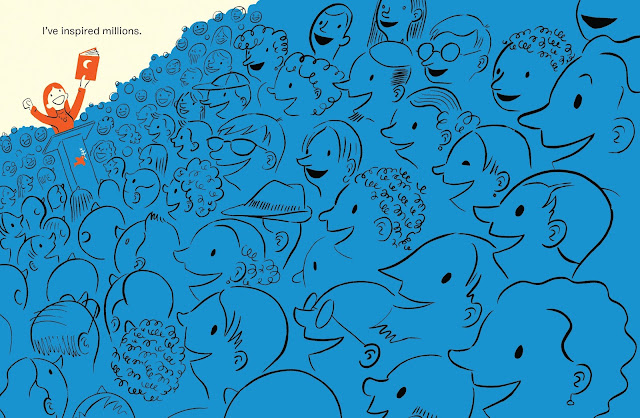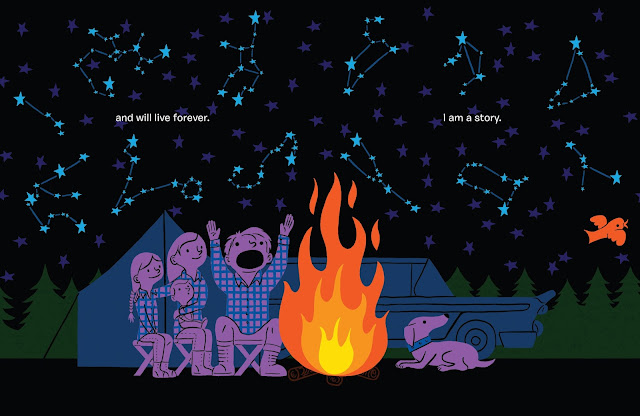Take a look at the trailer for my new picture book MORRiS MOLE here!
Wednesday, April 19, 2017
Monday, January 30, 2017
Wednesday, January 18, 2017
THE STORY BEHIND I AM A STORY Part 6
The last element of a picture book that is addressed is the cover.
The design and art is usually done after all of the art for the book has been completed. It's a very important component because it's the first thing you see and must encapsulate the idea and feel of the book into a single image. It's sort of like a poster or an ad for the book.
There were many ideas for the cover of I AM A STORY.
It proved to be difficult because the content wasn't a character in a story. It was an extremely broad view of thousands of years of different ways stories were presented.
So how to approach it?
I thought maybe showing bits and pieces from the interiors in a design.
Or go totally minimal.
Perhaps work vignettes into a design with the type.
Maybe make it less geometric.
Make it all about the title? With a hint of narrative?
How about more of a balance between title and image?
This felt right.
So that's the story behind I AM A STORY.
I am so thankful to Nancy Inteli and Rick Farley for all of their hard work and patience.
You can see the wonderful trailer HarperCollins created for it here. I think they did a fabulous job!
I've been creating books for 24 years. My fascination and love of the medium and it's possibilities continues to grow. I'm truly grateful to be able to continue to write and illustrate stories for children. I've always felt that children's books are the most important books we'll ever read and that a child's experience of a story can last a lifetime. I'm so grateful to be able to continue to create them.
I hope this in-depth look gives you an idea of what went into the creation of the book and what my intentions were.
Mostly I hope you enjoyed it.
Onward!
Monday, January 16, 2017
THE STORY BEHIND I AM A STORY Part 5
Since the book's publication, I've been asked who this woman was. To be honest, I had no one in particular in mind. I just wanted to depict someone before a crowd inspiring them with something from literature. Feel free to assign an actual person to this image.
You can probably tell I like drawing crowds.
The bird is used in a slightly different way here. He's more of a dove, which represents peace. I'm hoping this woman's oratory is inspiration for harmony and nonviolence, which I can't imagine anyone having a problem with.
On an art note, I started to work digitally about 5 years ago, my first book done in this manner was Doug Unplugged. Looking back, I see that there is a lot more line work in this book than any other I've ever done (except perhaps my next book, Morris Mole).
I find that every few years my technique evolves or changes slightly, but I think my style, the way I draw, hasn't. Someone once said to me, "Once you hit on your style, you'll never lose it and if you do, it wasn't your style."
The ebook spread has probably changed the most out of all of the images from rough to final.
Now stories can be experienced all over the world through digital technology. Hundreds of stories (text, audio, visual) now can be carried in your pocket on a small device and you can enjoy them everywhere at any time.
Look how far story has come!
You'll notice how the image evolves from rough, to line drawing, to final art.
I wanted to give this image a more global feel by including people in various cultural dress. It's by far the most detailed and complicated, as well as having the most Photoshop layers. I'm sure this one took the longest to do.
So the last spread.
For me, it goes right back to the beginning. The oral tradition will never die, at least I hope it doesn't. You'll notice that the figures are in the same positions as the prehistoric family, including the dog, which has become a bit more domesticated.
In a sense, we still tell stories about the same things, over and over.
And I guess we'll never tire of hearing them. I know I won't.
You'll notice I changed the drawings of the astrological signs in the first spread to the actual constellations.
And there goes the bird, forever flying onto the future, inspiring man to move ever forward to tell stories to the next generation in a new way.
Next: The cover and final touches.
Friday, January 13, 2017
THE STORY BEHIND I AM A STORY Part 4
The slow but constant evolution of how story has been conveyed has brought us to books and private libraries.
I explain at my school visits that a long time ago, books (and the ability to read) were only enjoyed by a select few. Fortunately, most kids today cannot comprehend this, which shows how far we've actually come.
I really enjoyed drawing the details of this 19th Century private library, as well as the wealthy magnate reading to his child.
Here is the rough sketch.
And here's the tight line drawing.
It's at this point, the somewhat chronological flow of the events takes a detour.
Yes, we've arrived at mass-produced books and the "modern era," but I wanted to stop marching ahead and slow down to examine the different aspects of how stories effect all of us.
And here's final art. Notice where the bird is. I suppose I'm suggesting that stories were cloistered by the wealthy and a few select others to enjoy and be enlightened by. It was in a sense held captive until...
Public libraries! Hooray!
You'll notice that the patrons waiting in line are holding books. I thought I shouldn't waste an opportunity to slip in a few classics here.
Goodnight Moon, To Kill a Mockingbird, and A Tree Grows in Brooklyn, all major examples of classic children's literature.
Now stories were available to everyone.
But where's the bird?
Look close! You'll find it.
See it?
Now stories can be enjoyed by everyone.
I wanted this image to contrast the private library spread by using bright colors and smiling faces.
I had no idea there were so many fun and interesting ways stories were brought to readers all over the world.
I also felt compelled to address some of the negative aspects of story. Although a difficult subject, I didn't feel that an examination of story would be complete without touching on censorship, book banning, and book burning.
At a school visit, a student was thoroughly confused by the concept of book burning. "Why would somebody do that? It's stupid."
Indeed.
Next: From the 20th to the 21st Century.
Monday, January 9, 2017
THE STORY BEHIND I AM A STORY Part 3
So how were stories conveyed after oral tradition? I imagined cave paintings were next when man began to evolve and develop a sense of objectivity about himself and the world around him.
I researched the cave paintings discovered in southwest France in Lascaux and remember studying them in school, but forgot how beautiful they were. I love doing research for my books because I learn new things and one of the things I learned was that these paintings were not merely of animals. They had another meaning, which I was totally unaware of and fit perfectly into the story.
As you'll see whenever the subject of the story is being depicted in I AM A STORY, it's in some way, shape, or form related to the night sky, the cosmos, as it was the very original subject on the title and campfire image page, which was then passed down from generation to generation. Well, I was concerned that the story man was conveying in the cave painting image was merely about things around him and his everyday experiences, but I was wrong- and relieved.
Among the animals, depicted are 3 bright stars we know today as the Summer Triangle, as well as a star cluster of the Pleiades sometimes called the Seven Sisters. So even here, I was able to keep the content being conveyed consistent.
It was also a star map. Whew!
Below is my original sketch for the dummy.
I printed out and pieced together some of the cave paintings and used it as my guide for the drawing. When Picasso went to Lascaux and saw the paintings he said that man had learned nothing new.
Now story would no longer need to be told by a particular person. It was depicted here for all time, or at least 16,500 years so far.
You'll also notice that the red bird makes an appearance, too. I thought it might be weird to have it flying by or perched on a rock inside the cave, but I thought a child wanting to imitate the artist by drawing it on a rock would be appropriate and a nice touch.
And here is the final image.
Moving ahead to stories written on clay tablets and in hieroglyphics, I did research on Sumeria, Mesopotamia and Egypt, which was fun for me. It has been said that the Sumerians invented writing (cuneiform), the stylus (used to write onto the clay tablets), the wheel, the plow, sewers, jewelry, bronze tools, geometry, medicine, architecture, and music, just to name a few.
So maybe it wasn't so strange that in my research I came across the image below of 3,000 year old hieroglyphs found in Seti 1's temple in Abydos, Egypt, of what I consider to be a helicopter, a plane, and a futuristic aircraft.
How could so many incredible things originate from a single culture? Perhaps some friends from another planet gave man a little help? Or time traveling future man checking in on his ancestor's progress? Just saying!
It's something to think about and for those of you who know me, it's something I think about a lot. I love science fiction and those of you who know my work, see it in some of my books.
Anyway, here it is. Let me know what you think.
Pretty wild, huh? I hope it's not a hoax.
Below is a depiction of two different forms of very early writing.
In the instance of the tablets, now you didn't need to go to a certain place (like the cave in Lascaux) to experience story, it was now portable (although incredibly heavy).
You'll notice that the bird appears in the sketch and line drawing for the Sumerian image.
It doesn't appear in the final of the Sumerian image.
Why? Because the bird is in the hieroglyphics! I tricked you.
I wasn't going to allow an opportunity to pass to be able to reinforce the subject matter of the story being conveyed. It took some doing, but I actually wrote out the beginning of the story of man's origin according to the ancient Egyptians. Some of it is obscured by the characters, but it's there. I didn't want to just put a meaningless jumble of symbols there when I could actually give it a purpose.
We move onto papyrus scrolls and tapestries.
Both of these images were single page and I completed them, but then my editor told me that the pagination needed to be changed, which completely changed 2 images. I created a double page spread depicting Japanese wood block printing, which then had to become a single page and my single page image of the tapestry and the king needed to become a double page spread!
Here are the line drawings of the components of the tapestry image, which I then arranged in Photoshop, then colored.
And here is the double page version of the tapestry spread. I actually like it more than the single page version.
We now move onto illuminated manuscripts created by monks in the early Medieval period, which I found fascinating. Here's the rough sketch.
And here is the very tight line drawing.
And here's the finish. Now multiple stories could be contained in a single volume.
I really enjoyed including small details like the cat and mouse. Did you spot the bird?
The next image, plays and performances, is one of my most favorite from the book. The lighting is dramatic and I got to draw dozens of faces in the crowd. I never actually come out and say the actor is performing a Shakespeare play, but I guess I sort of alluded to the Globe Theater in the final art, where many of his plays were performed.
Below is the rough sketch. I didn't know what I was in for until I did the line drawing.
Now that's a lot of people! It was fun drawing the costumes of the era, especially those frilly collars.
You don't see the bird right away, but he's there.
Now stories can be experienced in a dramatic setting with actors playing roles.
Around 1440, Johannes Gutenberg revolutionized how information (and for our purposes here, story) was disseminated around the world and we still feel it today. It was as profound as the wheel and the computer.
I wanted to show a busy printing shop.
You'll notice that the subject of what they are printing is still related to the cosmos, this time represented by prints of an engraving of the phases of the moon.
Now stories could be mass produced and distributed.
Next: The 20th and 21st Century.
Friday, January 6, 2017
THE STORY BEHIND I AM A STORY Part 2
Once I accumulated dozens and dozens of drawings, most of which were unusable (but led me to the ones that were), I sifted through them and kept the ones that had potential. I always like to have way more than I need rather than the opposite. I feel the same way about cooking. I've been accused of making way too much food, but hey, leftovers are not a bad thing.
I laid out the drawings more or less in chronological order, even though most of these mediums overlapped each other. There was no way to put them in any sort of totally accurate order, but I tried my best. From this I created a very rough book dummy, which consisted of black and white sketches and first draft text.
My editor Nancy Inteli at HarperCollins really liked the idea so we moved ahead with smoothing out the idea. Throughout the editing process, Nancy would send me suggestions and questions and I would reply with responses and answers. We did this a lot.
I mean a lot.
If you'll notice in most of my picture books, I tend to use the title page to start the story since there are only 16 spreads in a 40-page picture book (subtracting the front and back covers, the end pages, and title spread), so I try to use as much as I can.
I wanted to start the story with early man, so I came up with this image of a prehistoric man gazing up at the vast night sky with his son, to allude to the idea of generations and how it played into the book. I guess what I'm suggesting is that these stories are passed down to each generation, especially in the beginning, when it was an oral tradition. Someone had to hear and learn the stories and then pass them down to the next generation.
I also wanted to touch on the ideas of those first stories. I thought about early man and how he may have looked up at the night sky full of mystery, stars, and endless blackness. What did he think? How did he explain his existence or where he fit into the cosmos? Why was he here? Maybe he created stories to explain these things.
Perhaps these stories provided comfort in a cold, dark, confusing world that surrounded him. Maybe that's why we still tell those stories today.
I imagined he created stories about the stars in the sky above him. Perhaps this is the way the zodiac came into existence. I did some research and learned that astrology has a very ancient history. Perhaps those signs were the subject of man's earliest stories.
So I combined the image of early man around a campfire with the signs of the zodiac swirling in the night sky above to suggest that these are the stories he's telling to the rapt listeners huddled together on a cold night around a warm fire.
Then I started thinking about just what drove man to keep telling these stories. Why didn't they eventually stop being told? Why weren't they abandoned? What was that ineffable something, that desire to hand them down from generation to generation? Being a visual person and being that this was a picture book, I knew I had to depict this with an image. I also knew whatever it was, it had to appear throughout the story in order to string the images together.
This is what I drew.
To me, this represented INSPIRATION. I imagined that this bird flew through man's history, always moving ahead into the future.
And I wanted it to be red because red is such a powerful color for me. I didn't want too many things in the book to be red, so the reader could spot it. The bird is not in all of the images, but it's in all of the spreads (even the one spread you don't think it's in).
So on to the art.
First I take the rough sketch and place a sheet of frosted vellum over it. Then using the rough sketch as a guide, I redraw the image onto the vellum using India ink and a brush. I like using vellum because it's smooth so the lines are clean. I also use the blackest black ink I can find, so the lines are clear and dark.
This is the line drawing for the title page spread.
Then I scan the line art and open it in Photoshop, then apply color.
This is the final art once it was designed by the extraordinaire Rick Farley.
Next: Moving through history.
Subscribe to:
Posts (Atom)























































